Hildreth Meière Documentary Series - Watch Trailer
Hildreth Meière Documentary Series - Watch Trailer

Pioneering Art Deco muralist Hildreth Meière (1892-1961) transformed New York City architecture with dazzling mosaics, glass, metal and more. Working with leading architects of her day, Meière designed approximately 100 commissions during the span of her career.
In this self-guided tour, you’ll visit seven locations across New York City to see some of Meière’s iconic designs.
Explore her legacy hidden in plain sight on the Art Deco Trail.
For convenience and efficient travel, we suggest visiting the sites in the order below, based on a mix of walking and subway travel. Feel free to adjust based on your location or interests.
Use the map below to locate each point of interest or click on the items in the list for navigation instructions or to read more about the commission.
Please note: Each Deco Trail site is independently operated and may have varying hours or access policies. We recommend checking directly with the venue or using the links provided for the most current information.
Show on map
Title: “Dance”, “Drama”, and “Song”
Year: 1932
Location: 50th St facade, between 5th & 6th Ave, 60' above the sidewalk on the side of Radio City Music Hall building
Material: Mixed metal and enamel
Dimensions: 18 feet in diameter each
Executed by: Oscar B. Bach
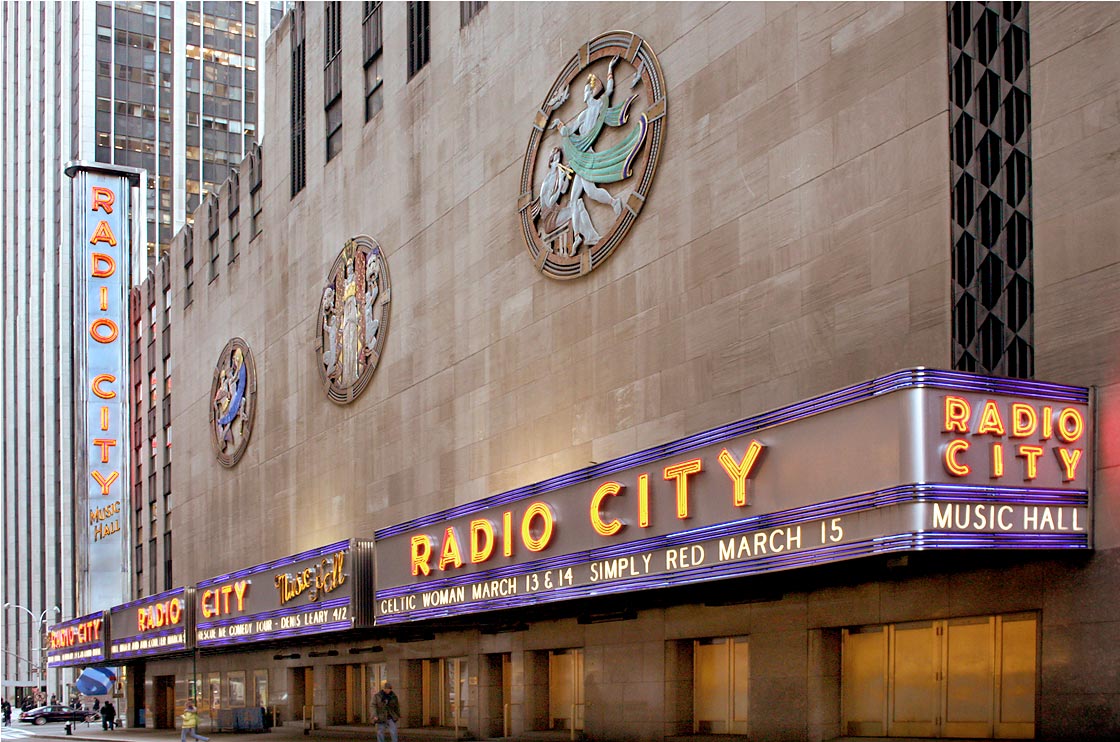
50th street facade of Radio City Music Hall with iconic Dance, Drama and Song in mixed metal and enamel
Quick Facts
A new method allowed for Meière to use a combination of mixed metals without concern of corrosion or limitations of color while at a scale never before attempted. The Roundels are so large, Bach fabricated by hand.
Visitor Access Info
✅ Confirmed Public Access: This site is open to the public daily and is visible from the street
Nearby Transit
48th/50 Sts - Rockefeller Center: B/D/F/M
49th St: N/R/W
50 St: 1
7Av/53: St B/D/E
Show on map
Title: “Annunciation”
Year: 1942
Location: The design on the front of the altar of the Lady Chapel, located at the back of the church, behind the main altar.
Material: Inlaid Marble
Executed by: Alexander Pelli and Company
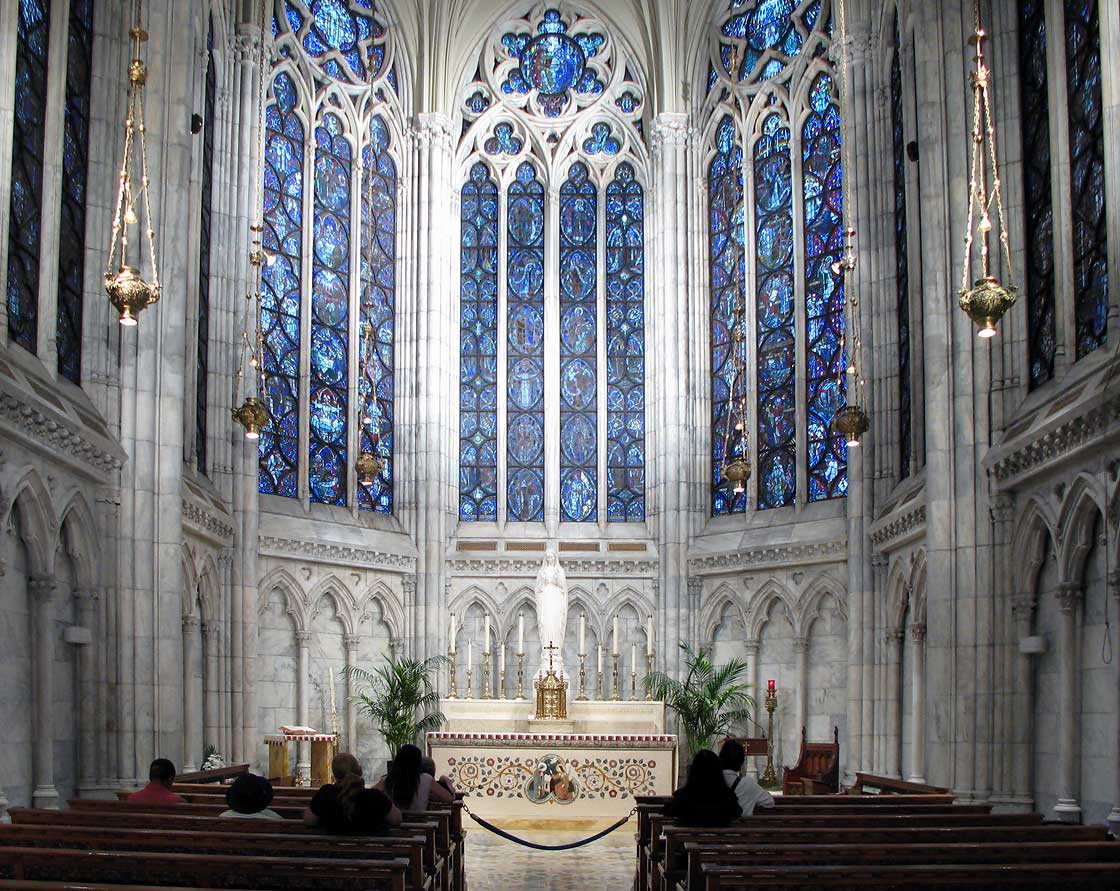
Altar frontal in Lady Chapel with the Annunciation
Quick Facts
Echoing the trefoil-shaped stone lancets of the surrounding walls, Meière set her scene against a trefoil-shaped marble medallion.
Visitor Access Info
🔒 Private or Limited - The Lady Chapel may be closed to the public or only viewable by special arrangement. Try viewing from outside the doors of the chapel www.museumpatron.org/faq's
Nearby Transit
5Av/53 St: E / M
51st: 6
Show on map
Title & Year:
A) “Transfiguration”, 1929
B) Stringcourse “Christian virtues”, 1929
C) Narthex domes and pendentives “Six Days of Creation”, 1930
D) Clerestory Windows (Stained Glass) “Magnificat”, 1948; “Gloria in Excelsis Deo”, 1949; “Nunc Dimittis”, 1955; “Benedicite”, 1956
Location: Click here for interior map of St. Bartholomew’s Church
Material:
A,B,C) Byzantine Glass Mosaic
D) Stained Glass
Fabricated by:
A,B,C) Pühl & Wagner
Executed by:
A,B,C) Ravenna Mosaics
D) Rambusch
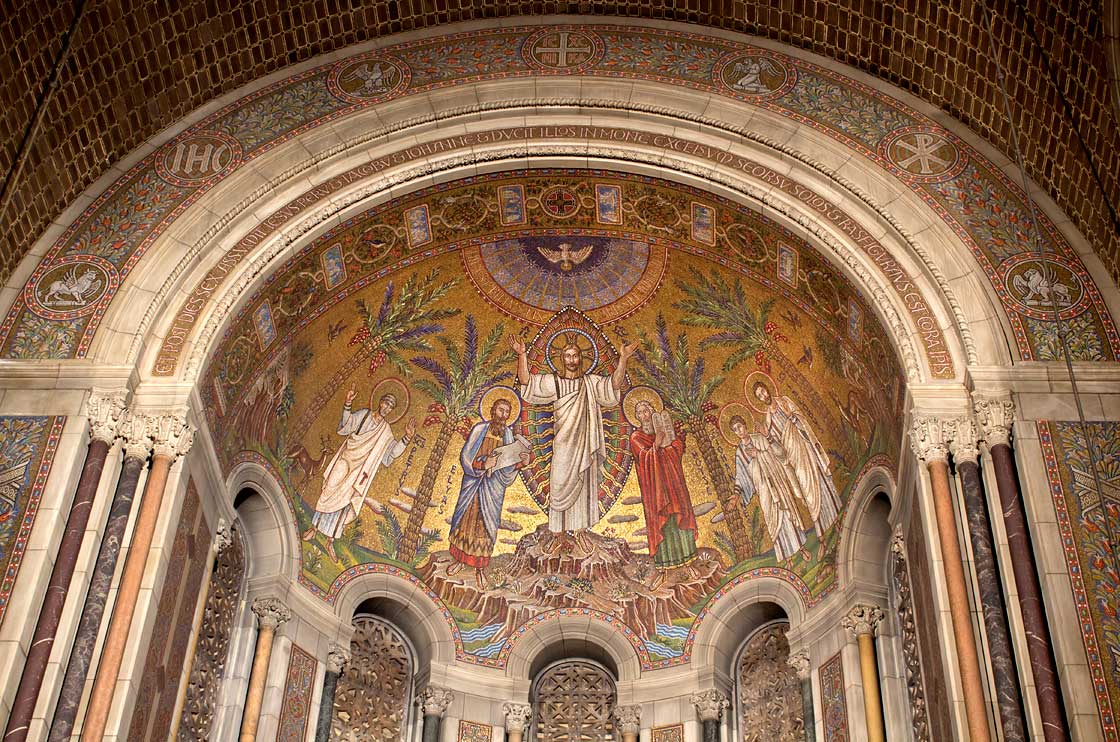
Detail of the Transfiguration in Byzantine-style glass mosaic
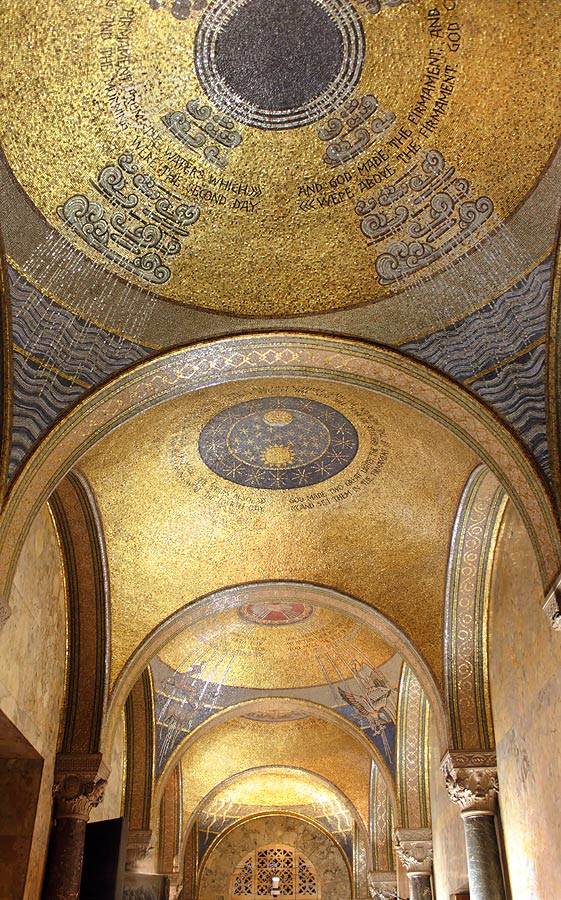
Narthex looking north with with Day Two of Creation in foreground

Magnificat
Quick Facts
Meière uses Art Deco elements throughout the designs in the church. The five narthex domes, in several hundred shades of gold, reflect the abstraction of early Byzantine mosaics used in Ravenna, Italy. The stained glass was Meière's first time using the medium and she used colored glass only as accent in order to let the most amount of light into the church.
Visitor Access Info
⚠️ Hours May Vary - Public access may vary.
Check ahead (scroll to bottom): www.stbarts.org/connect/im-new
Nearby Transit
51 St: 6
Lexington Av / 53 St: E/M
Read more about these commissions:
Half-dome of apse
Stringcourse
Narthex domes and pendentives
Clerestory windows
Show on map
Title: “Two Angels”
Year: 1935
Location: The wood cabinet Remembrance Shrine is located inside the church, currently located on the left hand side closer to the main entrance than the altar
Material: Paint, gesso, and gold enamel on wood
Executed by: Hildreth Meière

The Shrine of Remembrance
Quick Facts
When the doors of the shrine are open they reveal two angels, painted by Meière, in the special gold enamel process she has developed.
Visitor Access Info
⚠️ Hours May Vary - Public access may vary.
Check ahead: www.saintthomaschurch.org/visitor-information/
Nearby Transit
5Av/53 St: E / M
Show on map
Title:
A) “Main Arch with Judaic symbols”
B) “Ark with floral & geometric designs”
Year: 1929
Location: Visitor entrance is located at One East 65th Street, New York City. Mosaics are in the six story high arch that surround both the altar (bimah) in the main sanctuary and the doors to the Ark.
Material: Byzantine-style glass mosaic
Fabricated by: Pühl & Wagner
Executed by: Ravenna Mosaics
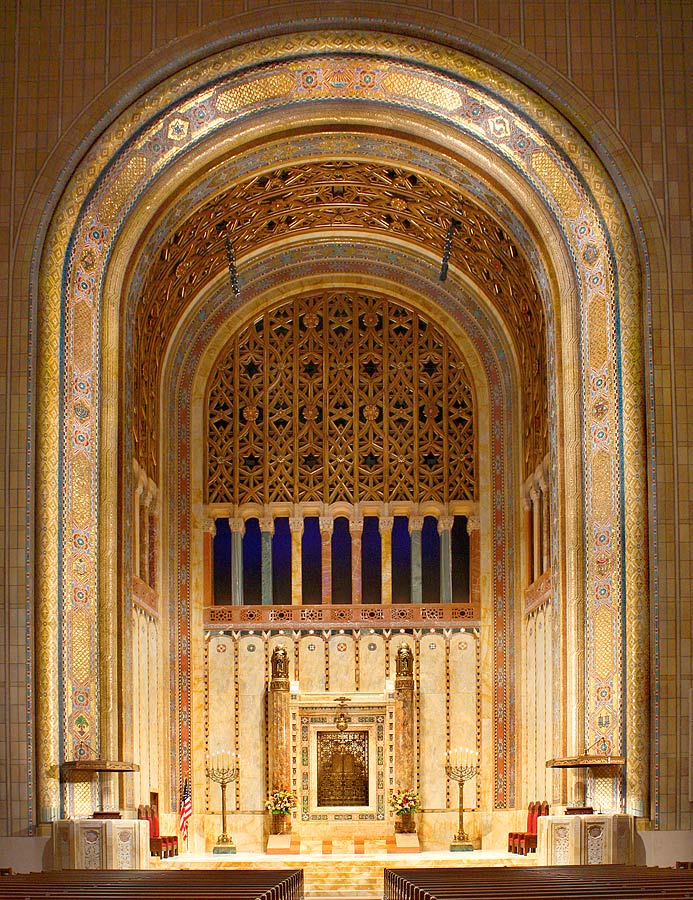
Six-story-high arch in main sanctuary with Ark on eastern wall
Quick Facts
Check out Day Two of Creation in the Arch. Meière was working on St. Bartholomew’s at the same time, where she visualized it differently—showing her range in style and imagery. Fun fact: When the mosaics were cleaned in 2005, only 6 of the millions of individual tesserae in the arch became loose, demonstrating the durability of the materials.

Day Two of Creation
Visitor Access Info
⚠️ Hours May Vary - Public access may vary.
Check ahead: www.emanuelnyc.org/about-us/tour-temple-emanu-el
Nearby Transit
68 St - Hunter College: 6
59 St - 4/5
Lexington Av / 63: F/N/Q/R
Read more about these commissions:
Sanctuary Arch
Ark Mosaics
Show on map
Title: “Red Room” Abstract Design
Year: 1931
Location: The “Red Room” is located inside Printemps New York flagship store, One Wall Street entrance or via store main entrance on Broadway between Wall St. and Exchange Pl
Material: Glass Mosaic
Dimensions: Over 7,791 sq ft of glass mosaic tesserae (about 3 million) that cover the walls and ceiling of the 13,000 sq ft room
Fabricated by: Pühl & Wagner
Executed by: Ravenna Mosaics
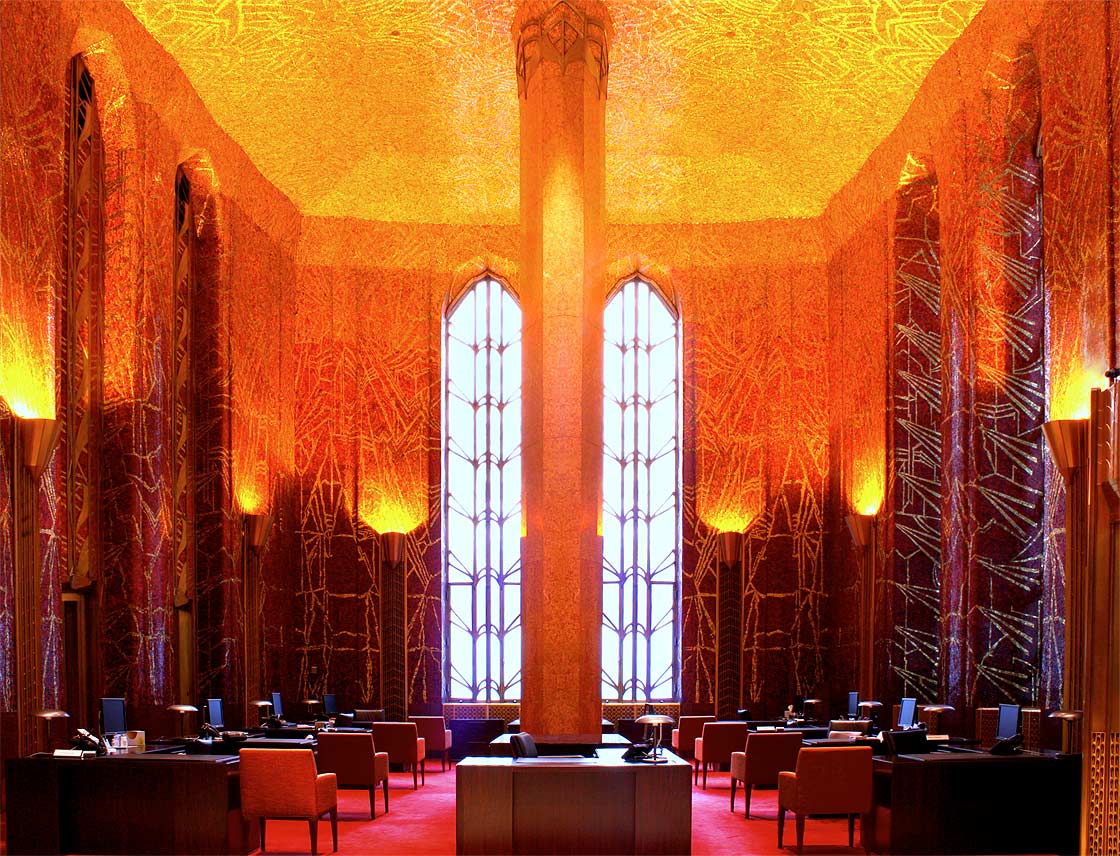
Banking Room in glass mosaic
Copyright, International Hildreth Meière Association
Quick Facts
The “Red Room” wall and ceiling mosaics are the only fully abstract design Meière is known to have created. From a private banking hall to a luxury condo sales gallery—and now Printemps New York—the “Red Room’s” evolution is a story of enduring artistry, adaptive reuse, and cultural appreciation. This design is protected as a designated interior landmark.
Visitor Access Info
✅ Confirmed Public Access - This site is open to the public daily. Check Hours (Scroll to Bottom): https://us.printemps.com/plan-your-visit#directions
Nearby Transit
Wall Street: 4/5
Wall Street: 2/3
Rector Street: N/R/W
Broad Street: J/Z
Show on map
Title:
A) “Continents Linked by Telephone and Wireless”
B) “Telephone Wires and Radio Unite to Make Neighbors of Nations”
Year: 1932
Location: Located inside 32 6th Ave entrance lobby, Map on wall to the right and ceiling silhouette mosaics in the lobby
Material:
A) silhouette glass mosaic and colored plaster
B) building tile
Executed by:
A) Ravenna Mosaics
B) Continental Clay Products
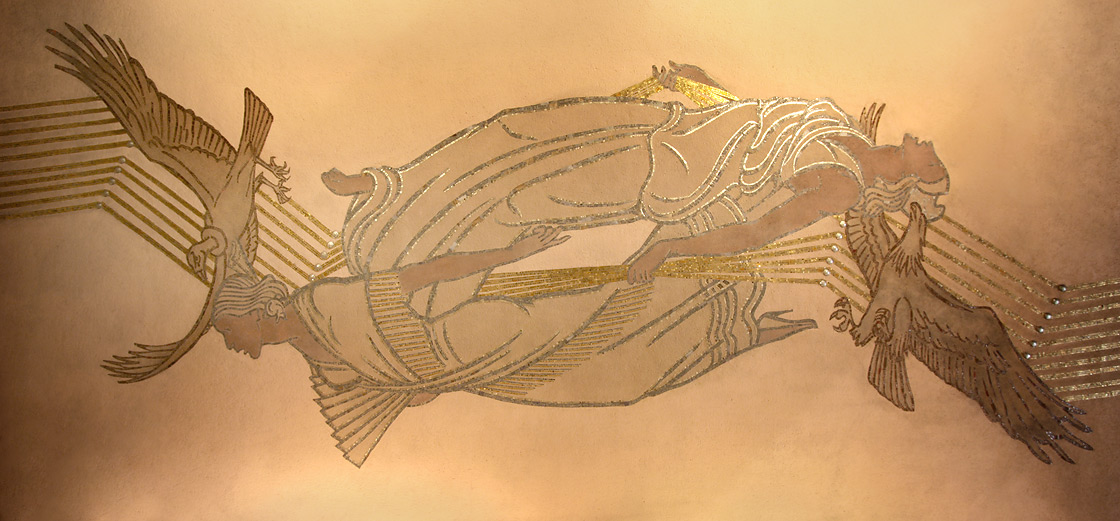
Center of ceiling with female messengers, a condor and eagle, and telephone and telegraph wires
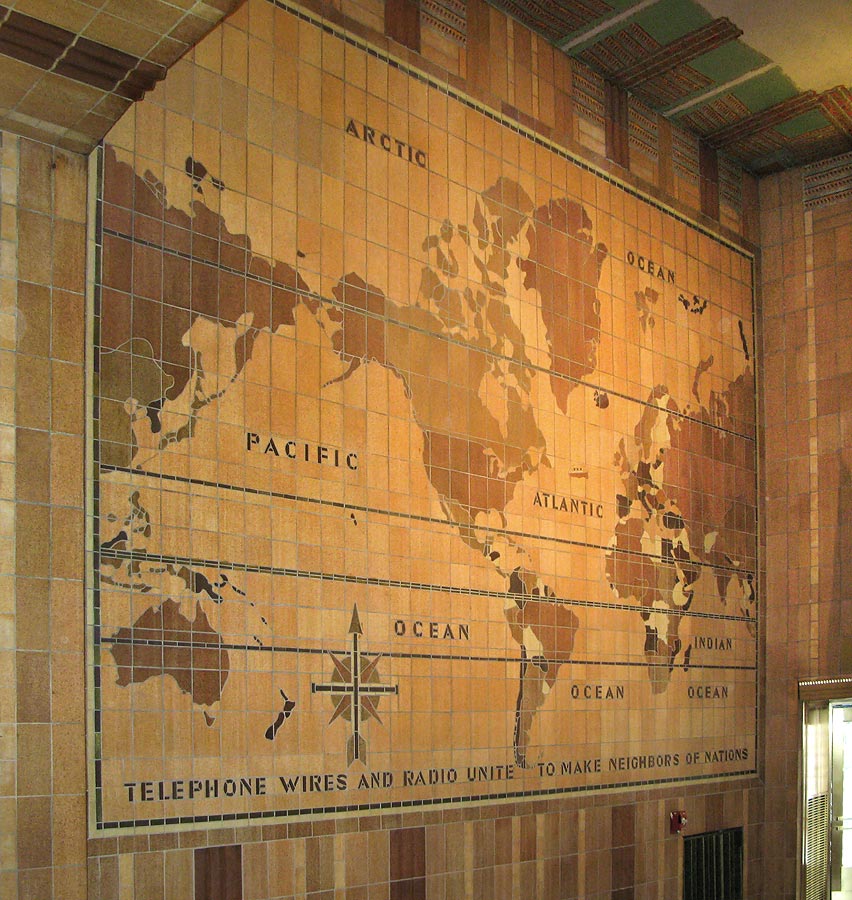
Telephone Wires and Radio Unite to Make Neighbors of Nations, map at lobby entrance
Quick Facts
Meière came up with an Art Deco design in silhouette mosaic (economical for the time) that would symbolize the original purpose of the building as a vital center of international communication for AT&T. Notice the female messengers at the center of the ceiling, surrounded by the continents of Europe, Africa, Asia, and Australia along the perimeter. This design is protected as a designated interior landmark.
Visitor Access Info
✅ Confirmed Public Access - This site is open to the public daily while security guards are present during normal business hours.
Building Website: www.rudin.com/commercial-properties/32-avenue-americas
Nearby Transit
Canal Street: 1 / A / C / E / N / Q / R / W / 6 / J / Z
The prominent American artist Hildreth Meière undertook more than 100 major commissions from leading architects for projects across the United States. Her impressive career extended from the mid-1920s until her death in 1961. You can still see Meière’s designs today at sites throughout the country, and New York City boasts some of her most significant works that show her artistic range.
Art Students League, California School of Fine Arts, Art Institute of Chicago, School of Applied Design for Women, Columbia University, WWI US Navy service
Paint, glazed ceramic tile, marble mosaic, glass mosaic, stained glass, terra cotta, gold and silver leaf, gesso, leather, wood inlay, mixed metal and enamel
1928 Architectural League of New York, Gold medal in mural decoration. 1956 American Institute of Architects, Fine Arts Medal, "Master of Murals" citation